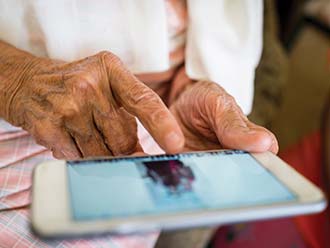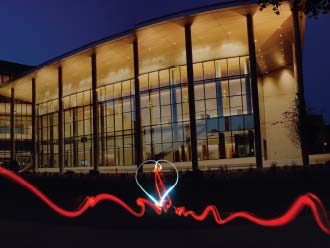The act of creating art is more than just a lightning strike of inspiration; it’s work. And as UTA alumna and lecturer Billi London-Gray will tell you, it’s the work part that is often the most gratifying. “I’m actually most creative under pressure, as a problem-solver with a deadline and limited means,” she says. “When necessity is the mother of invention, it’s still creativity—even if it feels like a tight, sweaty headspace.”
Still, inspiration is part of that mix of what goes into creation, and it’s that problem-solving piece that drives much of London-Gray’s art. “My work responds to problems I see in the world, especially complex, far-reaching societal problems, like inequality, bias, and complacency. I’m inspired by the idea that these problems, while immense, are not impossible, and that my work can do something to effect change.”

Billi London-Gray (far left) leads a group of local high school students through a Loop and Saw Choir session during the Department of Art + Art History’s Exploration Day.
With such an open-minded, experimental focus, her art is similarly open-ended. She works with a range of media, including ink, charcoal, paint, LEDs, photocopies, and more. One of her most recent projects is The Loop and Saw Choir, which consists of workshops, jam sessions, and performances in which she collaborates with volunteers of all ages and abilities to make music and sound art using musical saws, analog synthesizers, human voices, homemade instruments, and looping devices. In August, she won a Puffin Foundation grant for The Loop and Saw Choir, allowing her to purchase permanent equipment for the project.
London-Gray credits UTA’s MFA program for emboldening her open, anything-goes approach to creating art. “UTA allowed me to continue my practice of working with all sorts of materials and between disciplines, so that was a huge draw. I wanted to work with certain faculty members who had similar practices,” she says. “My professors and peers challenged me to reconsider my goals, remove the chaff, identify my audience from everybody out there, and really own my creative choices.”
How to be Creative
“I think all people are innately creative,” London-Gray says. “We are wired to learn, assess, and invent.” To that end, she shared some ideas on how to help anyone uncover their creative selves.
- Convince yourself to be brave.
- Tune out the voices that tell you how you ought to be.
- Discipline, discipline, discipline.
- Reframe your thinking. (“Maybe that’s the trick: Reframing how you define creativity so that you recognize it in what you already do.”)




